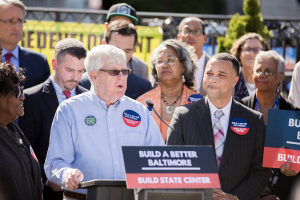
Politicians and neighbors rally for State Center renovation.
State Center redevelopment is back in the news. For about 15 years, the Bolton Hill Community Association and 11 other community organizations adjacent to the 28-acre State Center campus, which centers on West Preston Street, have worked together (via the State Center Neighborhood Alliance – SCNA) to get a redevelopment of the site that reflects the needs of these neighboring communities.
The latest news is the inclusion in April of $50 million dollars in the new Maryland supplemental state budget. The primary purpose for that money is to move employees from their current State Center offices to new ones in Baltimore’s downtown central business district. The relocation is to help alleviate the downtown office vacancies and the lack of business for downtown eateries and retail establishments — caused by the COVID-19 pandemic.
There’s broad discretion for use of the allocated $50 million—anything from buildouts in new office space, to moving costs, to demolition of existing State Center buildings. The intent is that the funds are to be used to keep these state employees in the city.
It is expected that employees will be moved out of entire buildings, rather than moving their agencies piecemeal. This would make it easier to move to demolition and therefore make it easier for redevelopment. The funds are from federal COVID relief, so they need to be applied to a one-time use.
Sen. Bill Ferguson (D-Baltimore), president of the senate, recently told representatives of several community groups that he has wanted to keep employees at State Center since the lawsuits began and stalled redevelopment. However, as COVID has destabilized downtown — where about a quarter of office space is currently vacant — Ferguson changed his mind this spring.
He then worked to make this supplemental appropriation happen in the closing weeks of the General Assembly session, realizing that state employees could help stabilize downtown and keep them in the city. He also pointed out that no city with a dead downtown can expect a healthy uptown.
There are 12 agencies at State Center, and it isn’t known if all or only some of them will be moved. It is thought that the Department of Human Services (DHS) will be the first agency relocated. It isn’t currently on the State Center campus but does need to move from its current location, and part of the $50 million will ensure that those employees stay within the city, as well. The first agency moved from the State Center campus is likely to be the Department of Health (MDH).
It can take 18-24 months to orchestrate a move, so it is not likely that current Gov. Larry Hogan will be determining what happens with State Center after employees are moved. His term ends next year.
Although in a year or two we may see a State Center campus empty of its current employees and even turned into totally open space with its buildings demolished, it is unknown what will happen next. A contract for demolition can’t occur before a contract to move is done.
Nevertheless, we who live nearby can begin to dream and plan what might happen. The plan created in cooperation with the current developer, the state and SCNA before Hogan took office took a lot of time and compromise to develop and gain the approval of so many constituencies. However, that work had the constraint that most current buildings would be remaining on the campus. If the campus is totally or mostly empty of buildings, then dreams and plans could go in totally new directions. SCNA members and other constituencies are ready to do this work. In fact, state legislation passed several years ago at SCNA’s instigation requires that any new development at the site have participation from SCNA and other community partners.
Complicating immediate redevelopment are the dueling, unresolved lawsuits launched several years ago. Both the state and the current developer agree that there were pre-construction costs owed to the developer. However, they disagree on the amount. Furthermore, the dispute over lost profits due to the leases for state occupancy of redeveloped space being withdrawn is far from over. Although some say that discovery has been completed, some parties were still being deposed in the past month. The lawsuits are unlikely to go to trial before the end of 2021, and settlement is unlikely during the Hogan administration. It is also unlikely the allocated $50 million would be used to offset lawsuit costs
Hopefully, a new redevelopment plan for State Center will arise from these recent events, with significant community input. The surrounding communities have already played a huge role in one plan for State Center, complete with a legally binding community benefits agreement, and a state law requiring community input. Perhaps now we can do another.
-John E. Kyle, president of SCNA. David Nyweide contributed to this article.
